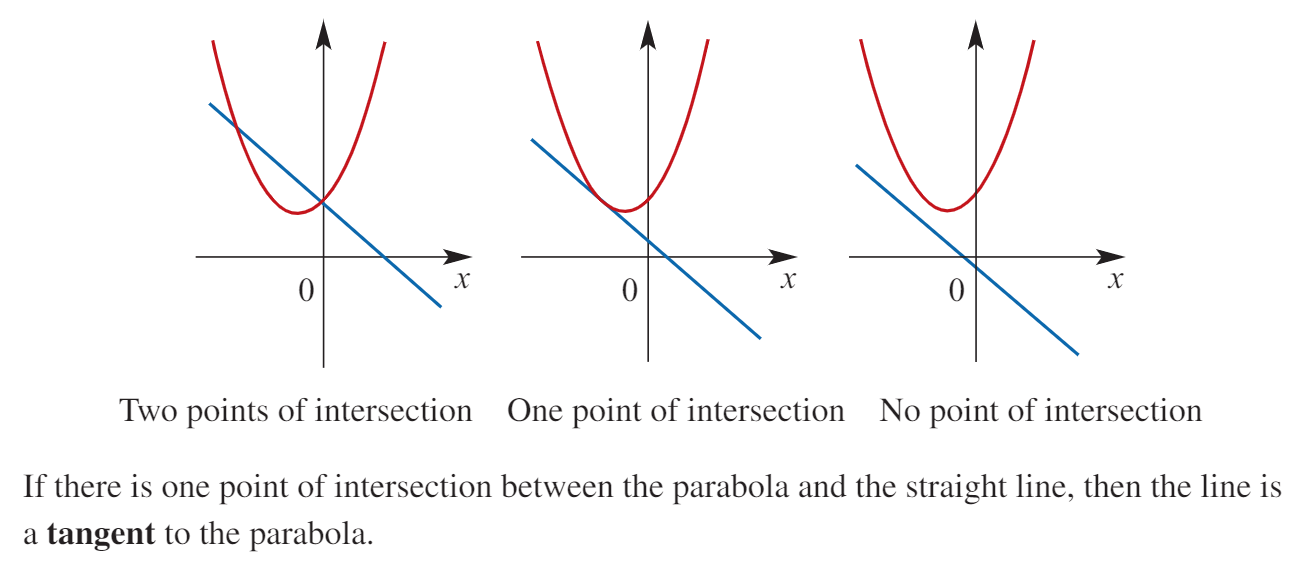Chapter 3: Quadratics
1/17
Earn XP
Name | Mastery | Learn | Test | Matching | Spaced |
|---|
No study sessions yet.
18 Terms
Distributive Laws
a(b±c) = ab±ac
(a+b)(c+d) = ac+ad+bc+bd
Perfect Squares
(a+b)² = a²+2ab+b²
(a-b)² = a²-2ab+b²
Difference of Perfect Squares (DOPS)
(a+b)(a-b) = a²-b²
Factorisation
Taking out the common factors
Grouping terms (X = ac, + = b)
e.g. x²+3x-10 → 5*-2 = -10 = ac, 5+(-2) = c = b
= x²+5x-2x-10
= x(x+5)-2(x+5)
= (x-2)(x+5)
Monic Quadratics
x²+(m+n)x+mn = (x+m)(x+n)
Non - Monic Quadratic Trinomials
Two numbers to give a*c and b when a+c;
Split bx, then factorise by grouping.
e.g. 6x²+19x+60
15×4 = 60
∴ 6x²+4x+15x+60
=3x(2x+5) + 2(2x+5)
= (3x+2)(2x+5)
Tip: How to find perfect squares (completely optional ;)
Check if a/c are square numbers
check if a*c/2 = b
If all are satisfied, then it is a perfect square (depending on the positivity of bx; if positive, the square is positive, or vice versa).
e.g. 16x²-40x+25
16x² = (4x)²
25 = (5)²
16×5/2 = 40 (ignore pos/neg here)
∴(4x-5)².
Completing the Square
BHS Rule: add and substract (b/2)² - factorise by DOPS (surd allowed).
Quadratics Formula and the Discriminant
Quadratics Formula: (-b±√(b²-4ac))/(2a).
Discriminant (denoted by the greek letter delta ‘Δ’): b²-4ac
When Δ < 0, no real solutions (as √Δ = √-num, undefined)
When Δ = 0, real solution (x = -b/2a)
When Δ > 0, 2 real solutions (x = quadratics formula)
Turning Point
Formula: a(x±h)²+k=0, (±h, k) as turning point.
Second Formula: h = -b/2a, k = c-b²/4a (or sub x value to original equation)
Axis of symmetry: x = h/-h
Tip: y-int = c
Sketching by completing the square
To sketch a quadratic in y=a(x-h)²+k (from ax²+bx+c):
Determine the tp (h,k): if a is positive, tp is min; if a is negative, tp is max.
Determine y-int by x=0; (if any) determine x-int by y=0, DOPS.
Tip: to solve x²=a, a>0, take √a for roots.
Sketching using Quadratic Formula
For y=ax²+bx+c:
y-int at y=c (x=0); x-int at y=0;
Use quadratic formula for x-int:
Discriminant (Δ): b²-4ac.
If Δ < 0, no real solutions (√-num =?)
If Δ = 0, one real solution (x=-b/2a, the only x intercept is the tp)
If Δ > 0, two real solutions (quadratic formula)
Sketching using Factorisation
To sketch a graph of a monic equation y=x²+bx+c:
Find y-int by sub x=0; find x-int by sub y=0 and factorise using the Null Factor Law.
Note: Null Factor Law: if a*b=0 then a=0/b=0
The tp is the axis of symmetry; use two x-values/int, sum, and divide by two.
Sub this x-value to find y coordinate of tp.
Sketching using Transformations
y=a(x-h)²+k
tp = (h,k), axis of symmetry at x = h
If a>0, the parabola is upright; a<0, inverted.
Solving Quadratic Inequalities
Inequality Symbols
"<" or ">": Use an opened circle + arrow indicating directions when graphing / Shading.
Example: x² - 4 > 0 → dashed curve at x = -2 and x = 2, shading outside."≤" or "≥": Use a closed circle + arrow indicating directions when graphing / Shading.
Example: x² - 4 ≤ 0 → solid curve at x = -2 and x = 2, shading between the roots.
Shading Direction
"<" or "≤": Solution is inside the curve.
Answer: value < x < value.
Example: x² - 4 ≤ 0 → answer: -2 ≤ x ≤ 2 (shade between the roots).">" or "≥": Solution is outside the curve.
Answer: x < value or x > value.
Example: x² - 4 > 0 → answer: x < -2 or x > 2 (shade outside the roots).NOTE: WHEN NEGATIVE, REVERSE EVERYTHING.
Discriminant: Advanced
If Δ = b²-4ac is a perfect square i.e., 1,4,9, etc. and Δ≠0, two rational solutions.
If Δ = b²-4ac = 0, one rational solution
If Δ = b²-4ac is NOT a perfect square and Δ>0, two irrational solutions.
Solving Simultaneous Linear and Quadratic Equations
Form the quadratic equation.
ax² + bx + c1 = mx + c2
Rearrange the equation so that the right-hand side is zero:
ax² + (b − m)x + (c1 − c2) = 0
Solve equation for x and substitute x-values into LINEAR EQUATION to find the y-values.
If ∆ > 0, two intersection points.
If ∆ = 0, one intersection point.
If ∆ < 0, no intersection points.

Families of Quadratic Equations
y = a(x − e)(x − f) - This can be used if two x-axis intercepts and the coordinates of one other point are known.
y = a(x − h)² + k - This can be used if the coordinates of the turning point and one other point are known.
y = ax² + bx + c - This can be used if the coordinates of three points on the parabola are known.